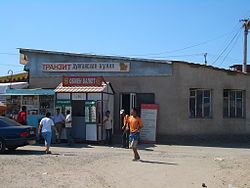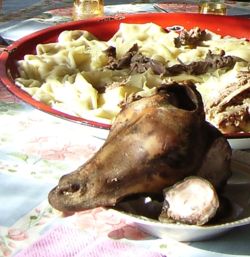- Kyrgyz cuisine
-
Kyrgyz cuisine, originating in Kyrgyzstan, is similar in many respects to that of its neighbors, particularly Kazakh cuisine.
Traditional Kyrgyz food revolves around mutton and horse meat, as well as various milk products. The cooking techniques and major ingredients have been strongly influenced by the nation's nomadic way of life. Thus, most cooking techniques are conducive to the long-term preservation of food. Mutton is the favorite meat, although many Kyrgyz are unable to afford it regularly.
Kyrgyzstan is home to many different nationalities and and their various cuisines. In larger cities, such as Bishkek, Osh, Jalal-Abad, and Karakol, various national and international cuisines can be found. On the road and in the villages, the cuisine tends to be standard Kyrgyz dishes, liberally flavored with oil or sheep fat, which are considered both delicious and extremely healthy by the local population.
Contents
Meat dishes
Meat in various forms has always been an essential of Kyrgyz cuisine. Among the most popular meat dishes are horse-meat sausages, roasted sheep's liver, besh barmak, which is a dish containing boiled meat with thin noodles, and various other delicacies made from horse meat.
Besh barmak is the Kyrgyz national dish, although it is also common in Kazakhstan and in Xinjiang (where it is called narin). It consists of horse meat (and sometimes mutton or beef) boiled in its own broth for several hours and served over homemade noodles sprinkled with parsley and coriander. Besh barmak means "Five Fingers" in the Kyrgyz language, and is so called probably because the dish is typically eaten with the hands. Besh barmak is most often made during a feast to celebrate the birth of a new child, an important birthday, or to mourn a death in the family, either at a funeral or on an anniversary. If mutton is used instead of horse meat, a boiled sheep's head is placed on the table in front of the most honored guest, who cuts bits and parts from the head and offers them around to the other guests at the table.
Shashlik, skewered chunks of mutton grilled over smoking coals that come with raw sliced onions, is served in restaurants and often sold in the street. The meat is usually marinated for hours before cooking. Shashlik can also be made from beef, chicken, and fish. Each shashlik typically has a fat-to-meat ratio of one-to-one. They are delicious when eaten fresh off the grill, but after being allowed to sit for a time (as is often the case with street vendors) they cool into greasy blobs.
Shorpa (or shorpo) is a meat and vegetable soup.
Paloo
Paloo (Kyrgyz: палоо) is the Kyrgyz version of what is generally referred to as plov in Central Asian cuisine. It consists of pieces of meat (generally mutton or beef, but sometimes chicken) fried in a large qazan (a cast-iron cauldron) and mixed with fried shredded carrots and cooked rice. The dish is garnished with whole fried garlic cloves and hot red peppers. Uzgen paloo is made with locally grown rice from the southern Uzgen District of Kyrgyzstan. Shirin paloo, a close relative of shirin plov in Azerbaijani cuisine, is a vegetarian dish in which meat is replaced with dried fruits, such as prunes, apricots, and raisins.
Paloo is the Kyrgyzified form of the Persian word polow or polo, related in etymology to pilaf. In Russian the dish is called plov (Russian: плов), in Turkic languages ash, and in Tajik osh.
Noodles and dumplings
Manty are steamed dumplings filled with ground meat and onions.
 Many restaurants in Bishkek advertise "Dungan cuisine" (Дунганская кухня)
Many restaurants in Bishkek advertise "Dungan cuisine" (Дунганская кухня)
Samsi are little pockets of meat and vegetables wrapped in flakey pastry, very similar to Indian samosas. They are stuffed with mutton and fat most often, but are also made with chicken, cheese, cabbage, and beef. The can be bought in most bazaars or on street corners in larger cities.
Lagman (or laghman) is a very popular noodle dish. It consists of thick homemade noodles covered in chopped peppers and other vegetables and served in a spicy vinegary sauce. Lagman is served everywhere in Kyrgyzstan, but is said not to be a Kyrgyz dish at all, but rather a Dungan one
Bread and tea
Bread usually served is nan, traditional Central Asian flat bread, and thick, sturdy Russian breads are also popular. Bread and tea (nan y chai) are considered almost sacred in Kyrgyz culture. A good host always offers their guests bread and tea, even if the guests are only staying for a few moments. Kyrgyz bread is cooked over coals in tandoori-like ovens. It is round and relatively flat. The local people love to dip it in their homemade jams or ayran, soured milk.[clarification needed]
Beverages
A popular Kyrgyz beverage is kymyz (Kyrgyz: кымыз [qɯmɯs]), a slightly alcoholic drink made by fermenting mare's milk. This drink is considered to be the signature drink of Euroasian nomadic culture, as it is also consumed in Kazakhstan and Mongolia. Fresh kymyz is only available in the summer, from about May until August, when it can be purchased on the roadside in the mountains. However, you kymyz has been bottled for several years in Kyrgyzstan and can be purchased in shops and markets around the country.[citation needed]
There are many beverages which could be described as traditional Kyrgyz drinks. One such non-alcoholic beverage which is very popular in Kyrgyzstan, especially in the summer, is maksym, a slightly fizzy drink made by fermenting grains. Maksym was traditionally made in small quantities by women for family consumption; however, this drink was introduced as a commercial product in Bishkek by the company 'Shoro', after which it became widely available all over Kyrgyzstan. Maksym is usually made from malt, but other types of grains may be used in its preparation. There are different methods and recipes for it which vary by region. It is prepared by boiling grounded malt or other type of cereals in water. After reaching a certain state of readiness this substance is cooled and undergoes a fermentation process caused by yeast. Maksym is usually consumed chilled.[citation needed]
Another drink which is made from grounded cereals called jarma. It is made in almost the same way as maksym, except that it isn't fermented, instead it is mixed with ayran to make it slightly fizzy.[citation needed] Another fizzy drink made from ayran is chalap (sometimes marketed as Tan). Other traditional drinks are sheep's milk and its products (such as qurut), and camel's milk. The two primary companies which commercially produce Kyrgyz national drinks are Shoro and Enesay.
See also

Food portal References
- Kyrgyz national cuisine
- DutaFlavors.com Kyrgyz Food Recipes with step-by-step instructions and pics.
- Kyrgyzstan: What to eat and drink
- Kyrgyzstan: Common food
- Kyrgyzstan: Drinks
- Kyrgystan cuisine on wikia
External links
 Media related to Kyrgyz cuisine at Wikimedia Commons
Media related to Kyrgyz cuisine at Wikimedia CommonsAsian cuisine Sovereign
states- Afghanistan
- Armenia
- Azerbaijan
- Bahrain
- Bangladesh
- Bhutan
- Brunei
- Burma (Myanmar)
- Cambodia
- People's Republic of China
- Cyprus
- East Timor (Timor-Leste)
- Egypt
- Georgia
- India
- Indonesia
- Iran
- Iraq
- Israel
- Japan
- Jordan
- Kazakhstan
- North Korea
- South Korea
- Kuwait
- Kyrgyzstan
- Laos
- Lebanon
- Malaysia
- Maldives
- Mongolia
- Nepal
- Oman
- Pakistan
- Philippines
- Qatar
- Russia
- Saudi Arabia
- Singapore
- Sri Lanka
- Syria
- Tajikistan
- Thailand
- Turkey
- Turkmenistan
- United Arab Emirates
- Uzbekistan
- Vietnam
- Yemen
States with limited
recognition- Abkhazia
- Nagorno-Karabakh
- Northern Cyprus
- Palestine
- Republic of China (Taiwan)
- South Ossetia
Dependencies and
other territoriesCategories:
Wikimedia Foundation. 2010.



